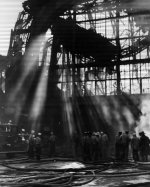Deadly 1946 fire destroys Staten Island Ferry terminal in St. George
Updated: Mar. 27, 2011, 4:00 a.m. | Published: Mar. 27, 2011, 3:00 a.m.
By
Staten Island Advance

Police, firefighters and workers gather in the ferry terminal after the horrific blaze was extinguished in this photo from 1946 (Staten Island Advance)
STATEN ISLAND, N.Y. -- One of the worst fires ever to strike Staten Island burned at a spot crucial to the borough’s livelihood.
On June 26, 1946, flames devastated the St. George ferry terminal, killing three people and injuring 280. The equivalent of nine alarms were transmitted, with fire engines streaming through the Holland Tunnel from Manhattan and over the Bayonne Bridge to reach the fire.
Passengers aboard the ferry boat Mary Murray, about to dock around 2:15 p.m., saw a faint cloud of smoke. Five minutes later, the boat was turned back; the terminal, as an Advance reporter described it, had become a “seething cauldron of flame.”
By the next morning, the Advance reported, the 41-year-old building “was a twisted mass of steel girders and wreckage.”
Some witnesses said the blaze began in the Staten Island Rapid Transit (SIRT) tracks adjacent to a waiting room. Others said it started in a paint storage room beneath the tracks. Luckily, a ferry had just departed, leaving the terminal virutally empty.
A West Brighton police officer told a reporter he ran toward the SIRT waiting room when he saw the smoke, only to be met by a man aflame from the waist up, screaming and running from the room.
“I shouted at him not to run, that he was fanning the flames,” the officer said. “He paid no attention, however, and rushed past me. I ran after him, grabbed him by the belt and tore the burning clothes from his back. I hurried him to a private car parked in the center of the viaduct, and told the driver to rush him to the hospital.”
A ferry worker was one of the first to discover the fire.
“I heard women screaming above me and when I looked up I could see them at the windows, through heavy clouds of smoke,” he said. One woman, he said, broke the glass and dived out head first, landing on a ferry employee. She died several days later.
Another witness said: “A bootblack named Frank had run into the women’s waiting room and tried to get through a window. I saw him struggling, but the heat was so intense I couldn’t get near him. I thought I saw something fall down and hit him. It was terrible.”
Flames raged quickly through the terminal building. When the first fire engines arrived, the heat was so intense they couldn’t get within 50 feet of the building. Twenty minutes later the viaduct to the terminal was a tangle of hoses as dozens of fire units poured water on the blaze.
Explosions were heard as flames engulfed the building and leaped 200 feet into the air. They were attributed variously to stored oil and girders falling from the superstructure.
Some 600 sailors from the U.S. Naval Berthing Facility in Tompkinsville were ordered to the terminal. Five fireboats and two Coast Guard boats joined the battle. All fire and police personnel on the Island were called to work and held over on their shifts. A gasoline tank truck had to be called to refuel fire engines working throughout the night.
By dawn the following day, the hangar-like terminal was virtually gone.
The irony of the tragedy was that plans to replace the outdated, overburdened terminal with a new, $11 million structure were being submitted to city officials at the moment the blaze broke out.
View full sizePolice, firefighters and workers gather in the ferry terminal after the horrific blaze was extinguished in this photo from 1946 (Staten Island Advance)STATEN ISLAND, N.Y. -- One of the worst fires ever to strike Staten Island burned at...

www.silive.com



